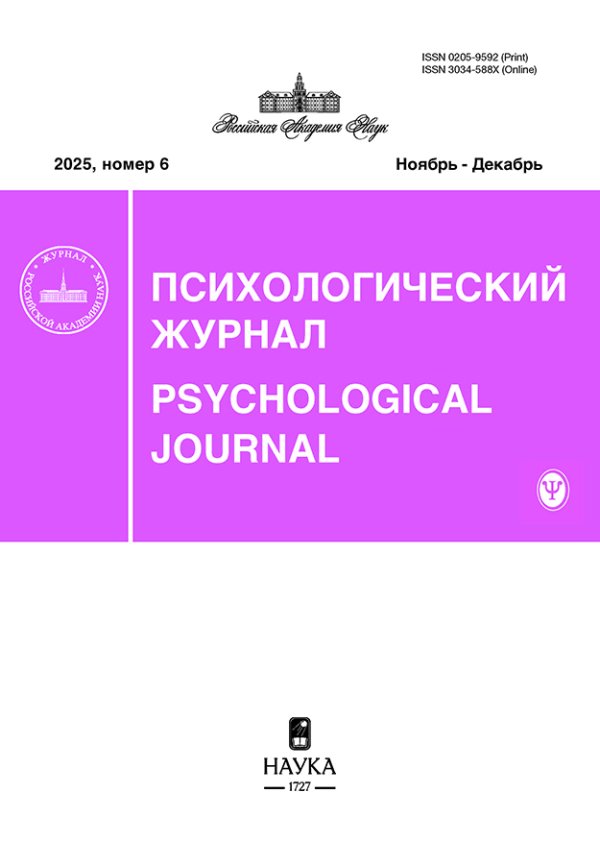Values and Planned Emigration Behavior Among Students from Three Countries. Part I. Introduction to Study
- Authors: Murashcenkova N.V.1,2,3, Gritsenko V.V.4, Efremenkova M.N.4
-
Affiliations:
- National Research University &apos
- Higher School of Economics&apos
- Moscow State Psychological and Pedagogical University
- Issue: Vol 44, No 3 (2023)
- Pages: 49-60
- Section: Cross-cultural psychology
- URL: https://journals.rcsi.science/0205-9592/article/view/140987
- DOI: https://doi.org/10.31857/S020595920026156-7
- ID: 140987
Cite item
Full Text
Abstract
About the authors
N. V. Murashcenkova
National Research University 'Higher School of Economics'Russian Federation, Moscow
V. V. Gritsenko
Moscow State Psychological and Pedagogical UniversityRussian Federation, Moscow
M. N. Efremenkova
Moscow State Psychological and Pedagogical UniversityRussian Federation, Moscow
References
- Гриценко В.В., и др. Тематические онлайн-форумы как пространство для принятия решения об эмиграции и преодоления пре-аккультурационного стресса // Психологический журнал. 2021. Т. 42. № 5. С. 69–79.
- Данилов А.Н., Ротман Д.Г. Молодежь современной Беларуси: базовые ценности, жизненные планы и поведенческие стратегии // Вестник РУДН. Серия: Социология. 2021. Т. 21. № 3. С. 469–481.
- Ильинский И.М., Луков В.А. Московские студенты: трансформации ценностных ориентаций // Вестник РУДН. Серия: Социология. 2020. Т. 20. № 1. С. 50–63.
- Молодежь в Содружестве Независимых Государств: статистический портрет. М.: Статкомитет СНГ, ЮНФПА, 2021. 166 с.
- Муращенкова Н.В., Гриценко В.В., Ефременкова М.Н. “Хочу” и “могу” в эмиграционном дискурсе российской студенческой молодежи в условиях пандемии COVID-19: роль индивидуальных ценностей // Социально-психологическая адаптация мигрантов в современном мире. Материалы 6-й Международной научно-практической конференции. М.: Перо, 2022. С. 151–159.
- Муращенкова Н.В. Взаимосвязь ценностей и эмиграционных намерений студенческой молодежи г. Смоленска // Социальная психология и общество. 2021. Т. 12. № 1. C. 77–93.
- Муращенкова Н.В. Психологические факторы эмиграционных намерений молодежи: обзор зарубежных исследований // Вестник Российского университета дружбы народов. Серия: Психология и педагогика. 2021. Т. 18. № 1. С. 25–41.
- Муращенкова Н.В. Эмиграционные интенции молодежи: теоретические основы изучения и категориальное разнообразие (обзор зарубежных исследований) // Современная зарубежная психология. 2021. Т. 10. № 3. C. 57–67.
- Наследов А. IBM SPSS Statistics 20 AMOS: профессиональный статистический анализ данных. СПб.: Питер, 2013. 416 с.
- Ромашева Ж.Ж., Калиниченко О.В., Малышев И.В. Связь базовых ценностей с эмиграционными установками российской молодежи // Известия Саратовского университета. Новая серия. Серия: Акмеология образования. Психология развития. 2021. Т. 10. № 4 (40). С. 323–333.
- Ромашева Ж.Ж. Эмиграционные установки молодежи северных и южных регионов Казахстана в зависимости от индивидуальных ценностей // Minbar. Islamic Studies. 2021. Т. 14. № 3. С. 703–730.
- Рязанцев И.П., Подлесная М.А., Богдан И.В. Универсализм ценностей студенческой молодежи и развитие российского общества // Вестник РУДН. Серия: Социология. 2021. Т. 21. № 1. С. 97–109.
- Социально-экономическое положение России (январь-июнь 2022). URL: https://rosstat.gov.ru/storage/mediabank/osn-07-2022.pdf (дата обращения 28.11.2022).
- Сычев О.А., Белоусов К.И., Зелянская Н.Л., Аношкин И.В. Миграционные намерения россиян: связь с идентичностью и моральными основаниями //Психологический журнал. 2021. Т. 42. № 3. С. 52–63.
- Титов А.С., Лепшокова З.Х. Индивидуальные ценности предпринимателей как предикторы их планируемого благотворительного поведения // Организационная психология. 2020. Т. 10. № 3. С. 140–163.
- Шарипова Д., Бейменбетов С. Молодежь в Казахстане: оценка ценностей, ожиданий и стремлений. Алматы, 2021. 98 с.
- Шварц Ш., Бутенко Т.П., Седова Д.С., Липатова А.С. Уточненная теория базовых индивидуальных ценностей: применение в России // Психология. Журнал Высшей школы экономики. 2012. Т. 9. № 1. С. 43–70.
- Эмиграционные настроения – 2020: где родился, там и пригодился. URL: https://wciom.ru/analytical-reviews/analiticheskii-obzor/emigraczionnye-nastroeniya-2020-gde-rodilsya-tam-i-prigodilsya (дата обращения: 29.11.2022).
- Эмиграционные настроения россиян. 2018. URL: https://wciom.ru/analytical-reviews/analiticheskii-obzor/emigraczionnye-nastroeniya-rossiyan-2018 (дата обращения: 29.11.2022).
- Эмиграционные настроения. 06.04.2022. URL: https://www.levada.ru/2022/04/06/emigratsionnye-nastroeniya-5/ (дата обращения: 29.11.2022).
- Эмиграционные настроения: мониторинг. 4 апреля 2022 г. URL: https://wciom.ru/analytical-reviews/analiticheskii-obzor/ehmigracionnye-nastroenija-monitoring (дата обращения: 22.11.2022).
- Ajzen I. Constructing a TPB questionnaire: Conceptual and methodological considerations. 2002. URL: http://www.people.umass.edu/aizen/pdf/tpb.measurement.pdf (accessed: 10.08.2022).
- Ajzen I. The theory of planned behavior // Organizational Behavior and Human Decision Processes. 1991. V. 50. № 2. Р. 179–211.
- Berlinschi R., Harutyunyan A. Do Migrants Think Differently? Evidence from Eastern European and Post-Soviet States // International Migration Review. 2019. V. 53. № 3. Р. 831–868.
- Carling J., Collins F. Aspiration, desire and drivers of migration // Journ. of Ethnic and Migration Studies. 2018. V. 44. № 6. P. 909–926.
- Collins F.L. Desire as a Theory for Migration Studies: Temporality, Assemblage and Becoming in the Narratives of Migrants // Journ. of Ethnic and Migration Studies. 2018. V. 44. № 6. P. 964–980.
- Dommermuth L., Klüsener S. Formation and realisation of moving intentions across the adult life course // Population Place and Space. 2018. V. 25. № 5. P. 1–24.
- Fishbein M., Ajzen I. Predicting and changing behaviour: The reasoned action approach. N.Y.: Psychology Press, 2010.
- Francis J., et al. Constructing questionnaires based on the theory of planned behaviour: A manual for health services researchers. Newcastle upon Tyne, UK: Centre for Health Services Research, University of Newcastle upon Tyne. 2004. URL: https://openaccess.city.ac.uk/id/eprint/1735 (accessed: 28.11.2022).
- Gorgievski M.J., Stephan U., Laguna M., Moriano J.A. Predicting Entrepreneurial Career Intentions: Values and the Theory of Planned Behavior // Journ. of Career Assessment. 2018. V. 26. № 3. Р. 457–475.
- Hooijen I., Meng C., Reinold J. Be prepared for the unexpected: The gap between (im)mobility intentions and subsequent behaviour of recent higher education graduates // Population, Space and Place. 2020. V. 26. № 5. P. 1–21.
- Kline R.B. Principles and practice of structural equation modeling. 3nd ed. New York: The Guilford Press, 2011. 432 p.
- Leong C.-H. The socio-psychological profile of prospective emigrants: Singaporeans leaving Singapore. // Immigration: Policies, challenges, and impact / Ed. E. Tartakovsky. Hauppauge, NY.: Nova Science Publishers, 2013. P. 29–49.
- Morell-Gomis R., et al. Predicting cannabis use among adolescents in four European Countries: combining personal values and the theory of planned behavior // The Journal of Genetic Psychology. 2020. № 181. P. 413–426.
- Schwartz S.H. Basic individual values: Sources and consequences // Handbook of value: perspectives from economics, neuroscience, philosophy, psychology and sociology / Eds. D. Sander, T. Brosch. Oxford University Press, 2015. P. 63–84.
- Schwartz S.H., et al. Extending the cross-cultural validity of the theory of basic human values with a different method of measurement // Journ. of Cross-Cultural Psychology. 2001. V. 32. №. 5. P. 519–542.
- Schwartz S.H. Instructions for Computing Scores for the 10 Human Values and Using them in Analyses. In Documentation for ESS-1. 2003. http://ess.nsd.uib.no/ess/doc/ess1_human_values_scale.pdf/ (accessed: 30.11.2022).
- Tabor A.S., Milfont T.L., Ward C. The Migrant Personality Revisited: Individual Differences and International Mobility Intentions // New Zealand Journal of Psychology. 2015. V. 44. № 2. P. 89–95.
- Tartakovsky E., Schwartz S.H. Motivation for emigration, values, wellbeing, and identification among young Russian Jews // International Journal of Psychology. 2001. V. 36. № 2. Р. 88–99.
- Tartakovsky E., Patrakov E., Nikulina M. Motivational goals, group identifications, and psychosocial adjustment of returning migrants: The case of Jews returning to Russia // International Journal of Psychology. 2017. № 52. P. 78–86.
- Van Dalen H., Henkens K. Explaining emigration intentions and behaviour in the Netherlands, 2005–10 // Population Studies. 2013. V. 67. № 2. P. 225–241.
Supplementary files










